USA Coin Album: The Coinage of 1958 — Part 1
Posted on 5/14/2019
Why examine the coins of 1958, you say? Well, among the less remarkable events occurring in 1958 was the birth of a coin-crazy kid. Yes, last year I turned 60, and it seems like a good occasion to take a look at the coins of similar age and determine which of us has aged better.
The year 1958 proved to be the last hurrah for the Lincoln cent's Wheat Ears reverse, which would be replaced with the Memorial design for Abraham Lincoln's birth sesquicentennial in 1959. Since the nation was in an economic recession during 1958, mintages were down a bit from the huge productions of 1956-57. Never fear, as countless rolls of Uncirculated 1958 Philadelphia and Denver cents were saved at the time. Both issues are quite common in gem condition, with NGC having certified several thousand of each in the grades MS 65 RD (red) and MS 66 RD. The population drops off quite a bit above that level, with just a single 1958(P) cent certified as MS 68 RD and no 1958-D examples higher than MS 67 RD.
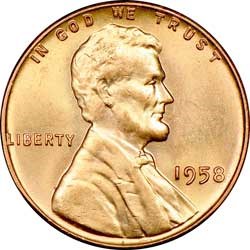 |
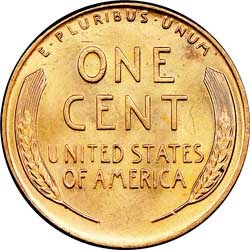 |
| 1958 1C Click images to enlarge. |
|
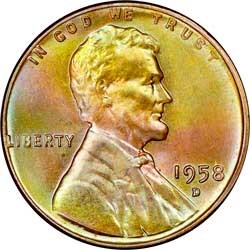 |
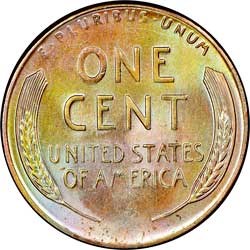 |
| 1958-D 1C Click images to enlarge. |
|
A speculative frenzy that developed in 1956-57 pushed sales of the 1957 proof set past a million. This was a wake-up call for the coin market and led to a temporary crash in prices. The setback lowered sales for the 1958 proof set 68 RD, and even PF 69 RD coins are sufficiently available to satisfy NGC's Registry Set participants. Cameo proofs of this date are in far shorter supply, with Ultra Cameo 1958 cents being genuinely rare. As of this writing, NGC had certified only 29 pieces as PF RD Ultra Cameo.
For the variety collector, there are some 23 repunched mintmark (RPM) varieties listed and illustrated at the extremely valuable website, varietyvista.com. NGC presently attributes just one of these, RPM-001 (VarietyPlus-001), which is triple punched, but others may be added as they are requested by customers. In the area of doubled-die obverse (DDO) varieties, there is an extremely rare and valuable entry for 1958(P) cents: DDO-001 (Fivaz-Stanton-101) is a spectacular variety that presently is known to the extent of just three examples.
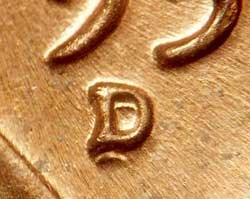 |
|
| 1958 1C RPM-001 Click images to enlarge. |
Both the Philadelphia and Denver Mints produced nickels in 1958, but their dates are about the only thing these coins have in common. The 1958(P) Jefferson nickel had a modest mintage for the time of only 17,088,000 pieces, while Denver coined more than 168 million, its highest output to date. The Philly nickels were poorly made, with dark planchets, heavily worn dies and poor strikes being the norm. 1958-D nickels also suffered some from worn dies, but the number of well struck examples is quite higher. Jefferson nickel specialists seek coins that are sharply struck on the six steps leading up to Monticello, and this quality is essentially unknown for 1958(P). NGC has certified only 47 pieces having 5FS (five full steps) and none having 6FS. In contrast, the 1958-D nickel boasts 304 coins certified as 5FS and 123 with 6FS.
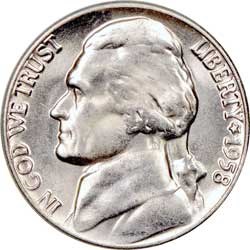 |
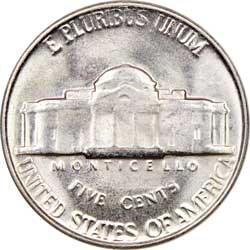 |
| 1958 5C Click images to enlarge. |
|
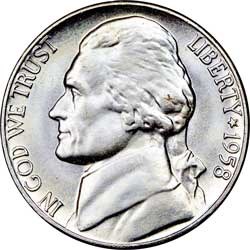 |
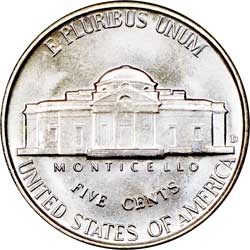 |
| 1958-D 5C Click images to enlarge. |
|
Coin collectors and speculators of that time monitored the monthly mintage figures published in The Numismatist, and they were thus alerted to the relatively small total of 1958(P) nickels. The trading in BU (Brilliant Uncirculated) rolls of current or recent coins was a powerhouse in the coin business during the 1950s and early '60s, so thousands of 1958(P) nickel rolls were put aside in anticipation of riches. There actually was a good payoff for those who sold their hoards by the middle of 1964, but after that time prices tumbled, and this segment of the market never really recovered. These days, surviving rolls are being cherrypicked for the very few coins that can achieve high certified grades, while the remaining pieces are difficult to sell.
The proof nickels dated 1958 are somewhat reflective (pardon the pun) of that year's cents, but they are even more rare displaying contrast between frosted devices and brilliant fields. This quality was lost after just the first few dozen strikes from fresh dies. Nearly all 1958 proof nickels are thus fully brilliant and often reveal overly polished dies on which the shallow details have been eradicated. Gems are plentiful, NGC having certified several hundred as PF 69, but the overall total for Cameo proofs is 302 coins, while a mere nine examples have been certified as PF Ultra Cameo.
There are no significant varieties for 1958 nickels of either mint. The few doubled-dies affect mostly the reverses of the proofs. These DDRs are difficult to distinguish and carry little or no premium.
Next month, I'll take a look at the quarters and halves of 1958.
David W. Lange's column, “USA Coin Album,” appears monthly in The Numismatist, the official publication of the American Numismatic Association.
Stay Informed
Want news like this delivered to your inbox once a month? Subscribe to the free NGC eNewsletter today!
